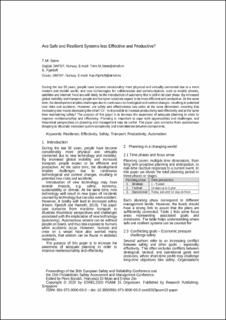| dc.contributor.author | Stene, Trine Marie | |
| dc.contributor.author | Fjørtoft, Kay Endre | |
| dc.date.accessioned | 2023-08-16T11:54:55Z | |
| dc.date.available | 2023-08-16T11:54:55Z | |
| dc.date.created | 2020-11-09T14:10:31Z | |
| dc.date.issued | 2020 | |
| dc.identifier.citation | E-proceedings of the 30th European Safety and Reliability Conference and 15th Probabilistic Safety Assessment and Management Conference (ESREL2020 PSAM15). 2020, 3717-3724. | en_US |
| dc.identifier.isbn | 978-981-14-8593-0 | |
| dc.identifier.uri | https://hdl.handle.net/11250/3084388 | |
| dc.description.abstract | During the last 50 years, people have become considerably more physical and virtually connected due to a more modern and mobile world, and new technologies for collaboration and communication, such as mobile phones, satellites and internet. Next era will likely be the introduction of autonomy that is still in its start phase. By increased global mobility and transport, people and transport solutions expect to be more efficient and productive. At the same time, the development implies challenges due to continuous technological and context changes, resulting in potential new risks and accidents. However, are safety and effectiveness two poles at the same dimension, meaning that increasing one means decreasing the other? Or - Is it possible to increase productivity and effectivity and at the same time maintaining safety? The purpose of this paper is to increase the awareness of adequate planning in order to improve resilience/safety and effectivity. Planning is important to cope with opportunities and challenges, and theoretical perspectives on planning and management may be useful. The paper uses scenarios from autonomous shipping to illustrate increased system complexity and interrelations between components. | en_US |
| dc.language.iso | eng | en_US |
| dc.publisher | Research Publishing Services | en_US |
| dc.relation.ispartof | e-proceedings of the 30th European Safety and Reliability Conference and 15th Probabilistic Safety Assessment and Management Conference (ESREL2020 PSAM15) | |
| dc.title | Are Safe and Resilient Systems less Effective and Productive? | en_US |
| dc.type | Chapter | en_US |
| dc.description.version | publishedVersion | en_US |
| dc.source.pagenumber | 3717-3724 | en_US |
| dc.identifier.cristin | 1846211 | |
| dc.relation.project | Norges forskningsråd: 267860 | en_US |
| cristin.ispublished | true | |
| cristin.fulltext | original | |
| cristin.qualitycode | 1 | |
